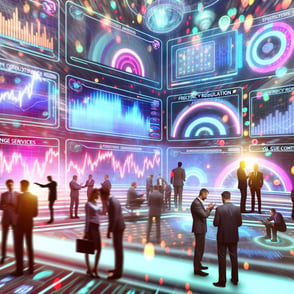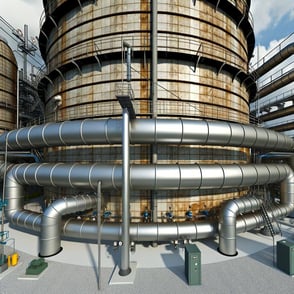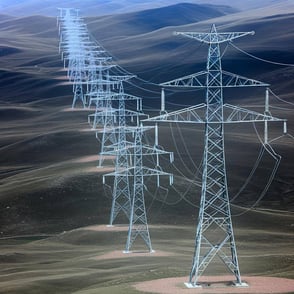Nuclear Energy Generation
Nuclear energy generates electricity through nuclear fission, where uranium atoms split to release heat. It's efficient and low-carbon, with potential for future fusion energy.
What is Nuclear Energy?
Nuclear energy harnesses the power of atomic reactions to generate electricity. This form of energy relies on the process of nuclear fission, where the nucleus of an atom splits into smaller parts, releasing a significant amount of energy in the form of heat. Nuclear energy is a powerful and efficient way to produce large amounts of electricity with low greenhouse gas emissions, making it a key component of the global energy mix, along with wind, photovoltaic and hydro energy.
How Nuclear Energy Generation Works
Nuclear power plants generate electricity through the process of nuclear fission. The core component of these plants is the nuclear reactor, where the fission process takes place. The most commonly used fuel in nuclear reactors is uranium-235, which undergoes fission when struck by a neutron.
In a nuclear reactor, uranium fuel rods are arranged in the reactor core. When a neutron collides with a uranium atom, the atom splits, releasing a large amount of heat and additional neutrons. These neutrons then collide with other uranium atoms, creating a chain reaction. The heat generated from this reaction is used to convert water into steam. The steam produced in the reactor is directed to a turbine. The high-pressure steam turns the blades of the turbine, which is connected to a generator. As the turbine blades spin, they drive the generator to produce electricity. After passing through the turbine, the steam is condensed back into water in a condenser and returned to the reactor to be heated again, completing the cycle.
To control the fission process and ensure safety, control rods made of materials like boron or cadmium are inserted into the reactor core. These rods absorb excess neutrons and can be adjusted to regulate the rate of the chain reaction. Additionally, the reactor is housed within a containment structure designed to prevent the release of radiation and protect against external hazards.

In addition to nuclear fission, nuclear fusion represents a promising frontier in nuclear energy. Fusion is the process by which two light atomic nuclei combine to form a heavier nucleus, releasing a vast amount of energy in the process. Unlike fission, which splits heavy atoms, fusion mimics the energy-producing reactions of stars. Fusion holds the potential for virtually limitless and sustainable energy with minimal environmental impact. Current pilot projects, such as the ITER (International Thermonuclear Experimental Reactor) in France, aim to demonstrate the feasibility of fusion as a practical energy source. These projects focus on achieving the extremely high temperatures and pressures necessary to sustain fusion reactions while addressing the engineering and material challenges involved. If successful, fusion could revolutionize the energy sector by providing a powerful, clean, and virtually inexhaustible source of electricity, significantly enhancing global energy security and reducing reliance on fossil fuels.
The Impact of Nuclear Energy on the Energy Sector
Nuclear energy has a significant impact on the energy sector due to its ability to generate large amounts of continuous, low-carbon electricity. It plays a crucial role in reducing greenhouse gas emissions and combating climate change. Nuclear power plants produce no air pollution during operation, making them an environmentally friendly alternative to fossil fuel-based power generation.
Economically, nuclear energy contributes to the stability and diversification of the energy mix. Nuclear power plants have high upfront construction costs but relatively low operating and fuel costs, providing a stable and predictable source of electricity over the long term. For this reason, nuclear power plants are low on the merit order seen in the marginal cost pricing system of the Day-Ahead Market. This makes nuclear energy an attractive option for countries seeking to enhance energy security and reduce dependence on fossil fuels.
Nuclear energy also supports economic growth by creating jobs in plant construction, operation, and maintenance. The development of advanced nuclear technologies, such as small modular reactors (SMRs) and next-generation reactors, holds the potential to further improve the safety, efficiency, and cost-effectiveness of nuclear power. Despite its benefits, nuclear energy presents several challenges, including the management of radioactive waste, the high cost of plant construction, and public concerns about safety. Advances in technology and regulatory frameworks are essential to addressing these challenges and ensuring the safe and sustainable development of nuclear energy.
Conclusion
Nuclear energy generation, through both fission and the emerging potential of fusion, offers powerful and efficient ways to produce electricity, providing significant environmental and economic benefits. By harnessing the process of nuclear fission, current nuclear power plants deliver a reliable source of low-carbon electricity, reducing greenhouse gas emissions and enhancing energy security. Meanwhile, advancements in nuclear fusion technology hold the promise of a future with a clean and inexhaustible power source. Together, fission and fusion represent complementary pathways to achieving a sustainable and secure energy future, addressing both present and future energy challenges.
Glossary
- Nuclear Fission: The process by which the nucleus of an atom splits into smaller parts, releasing a large amount of energy.
- Uranium-235: A commonly used fuel in nuclear reactors that undergoes fission when struck by a neutron.
- Reactor Core: The part of a nuclear reactor where the fission process takes place, containing the fuel rods.
- Fuel Rods: Cylindrical tubes that contain nuclear fuel, such as uranium-235, used in the reactor core.
- Chain Reaction: A series of fission reactions where neutrons released by splitting atoms cause additional fission events.
- Control Rods: Devices made of materials like boron or cadmium that absorb neutrons and regulate the fission process in a nuclear reactor.
- Containment Structure: A reinforced building designed to prevent the release of radiation and protect the reactor from external hazards.
- Steam Turbine: A device that converts high-pressure steam into mechanical energy to drive a generator.
- Condenser: A component that cools and condenses steam back into water for reuse in the reactor.
- Small Modular Reactors (SMRs): Advanced, smaller nuclear reactors designed for enhanced safety and efficiency.
- Radioactive Waste: Byproducts of nuclear reactions that remain radioactive and require careful management and disposal.
.png?width=200&height=80&name=etpa-logo-color%20(1).png)































.png)
.png)
-1.png?width=250&height=100&name=etpa-logo-color%20(1)-1.png)